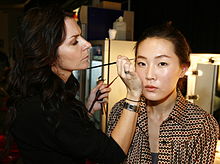Sunday, February 27, 2011
Mascara
In Media
In Media
Television
Makeovers are often popular television subjects. Long a staple subject of daytime talk shows, they have recently moved into the limelight in television shows such as Queer Eye. Other popular makeover shows include What Not to Wear, How to Look Good Naked, Extreme Makeover, MADE, Ambush Makeover and Pimp My Ride. See makeover reality television series.
Computer software and online tools can also be used for performing what are known as Virtual Makeovers. Using a photograph of a human face, software can apply cosmetics, hairstyles, and various eyewear such as contact lenses and sunglasses in order to allow users to visualize different looks without physically trying them on.
The term is also used with the word "girly" before it. This usually refers to a male going through a makeover into a girl; being dressed up and treated like a girl.
Books
There is also a series of books, aimed at teenage girls, called "The Makeover Series" written by Suzanne Weyn. There are several experts who perform the art of makeovers. Usually makeover artists specialize in hairstyling, make-up or clothing.
"The Makeover Guy" is a registered trademark for author and makeover expert Christopher Hopkins who is known for his television head-to-toe makeovers
Makeover
Makeover
A makeover is a term applied to changing one's appearance, sometimes through cosmetics. Makeovers can range from something as simple as a new haircut, to the use of cosmetic surgery, to the extreme of the implantation of dental veneers, eye-color-changing contact lenses, and the use of appearance-altering gastric bypass surgeries, providing massive, permanent fat loss in obese persons, and the associated plastic surgeries, such as abdominoplasty, to eliminate the resulting loose-hanging skin folds (the "panniculus").
Bridal Makeup
- Bridal Makeup
- Bridal Makeup is fast becoming a new segment within a makeup artists repertoire. From ethnic, to glamouros to contemporary, most makeup artists now are a major vendor within the wedding planning space in Asia, Europe and North America.
Special Effects Makeup (FX Makeup)
- Special Effects Makeup (FX Makeup)
- The use of special effects techniques enhancing physical features to exhibit metaphysical characteristics as well as fantasy makeup. The use of prosthetics and plaster casting are also required for projects that entails non-human appearances. Accents such as theatrical blood and ooze are also techniques applicable to this type of makeup
Theatrical Makeup
- Theatrical Makeup
- Stage makeup is used as a method in conjunction with stage lighting to highlight the actors' faces in order make expressions visible to the audience from moderate distances. This often includes defining the eyes and lips as well as the highlights and lowlights of the facial bones.
Fashion Makeup
- Fashion Makeup
- Fashion makeup is used in magazine photography as well as on the fashion runway. Avant Garde Makeup[9] is also an applicable technique used for projects that require experimental themes. Fashion makeup is also commonly used in television and film ranging for the natural prime look to more sophisticated applications such as color balance.
Make-up artist
Make-up artist
Lip plumper
Lip plumper
| |
Lip plumper is a cosmetics product used to make lips appear fuller. In appearance, it ranges from translucent to opaque and tinted. A lip plumper can be formulated to be worn alone as a lip gloss. Sheerer versions can be applied under lipstick.
Lip plumpers are used by those with thinner lips when full, "pouty" lips are desired। These products typically work by irritating the thin, delicate skin of the lips with ingredients like menthol or camphor. This makes the lips swell slightly, which may also diminish the appearance of fine lines in that area. Other perceived benefits include stimulating collagen production and moisturizing. A lip plumper's effects are temporary, so it must be reapplied throughout the day to maintain the results.
Lip liner
Lip liner
Types of Like lipstick,
Types
Like lipstick, lip gloss comes in a variety of forms and may be applied in different ways. It can be contained in a small cylindrical bottle and applied with a rounded or sloped applicator wand (known as a doefoot applicator), be applied with a built in lip brush, or a small tube designed for application with the fingertip. Solid glosses come in boxes and tubes, sometimes blurring the distinction between lip gloss and lip balm.
New types of "plumping" lip gloss contain ingredients which make the lips appear softer and plumper. These are a cheap, easy, and harmless alternatives to collagen, Restylane, Juvederm, and/or fat injections, but are often not as effective. The effects are temporary and short-lasting.
Lip gloss is often used when a person wants to have some color on their lips, but does not want an intense, solid lip color effect (i.e. a more "made-up" look), as lipstick would create. Lip gloss is also often used as a sort of introduction to makeup. It's often used by preteen and young teenage girls who want to wear some makeup, but are too young to wear a more intense lipstick color.
In 2009, a UK cosmetic company was the first company to include a Drink Spike Detector strip packaged with their Lip Gloss. Due to a sharp rise in Drink Spiking, Tracy Whittaker, CEO of 2 Love My Lips, made a conscious effort to raise the awareness of Drink Spiking by combining the two products. Completely supported by the Roofie Foundation, 2 Love My Lips is now sold in over 10 countries worldwide.


